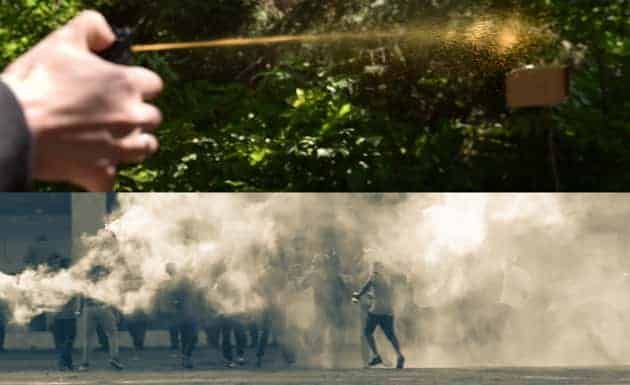Pepper spray and tear gas differ in chemical makeup, physical effects, and modes of delivery. You will learn about these differences in this article.
While their effects on the body are similar, pepper spray and tear gas are used for specific applications. In summary, this is what I learned about the differences between pepper spray and tear gas.
Pepper spray is used for self-defense and policing. Tear gas is effective at riot control and crowd dispersion because of it’s large area of effect.

Pepper spray and tear gas are effective at solving two different problems. Do you need a tool for stopping individuals or large groups? Think about what your target will be to decide which is best for you.
- Pepper spray is used to incapacitate one or more individuals. Because of this, pepper spray is great for self-defense and police work.
- Tear gas is good at stopping groups of people unlawfully congregating and acting in a specific area. Because tear gas contaminates a large area, it’s more effective than pepper spray for police action on large groups.
Tear Gas is a Lachrymator Agent

As lachrymator agents, various tear gas chemicals stimulate the nerves of the lacrimal gland to produce tears. These chemicals include capsaicin, CS, CR, and CN gas.
While pepper spray can be considered a tear gas because it causes tear production, it’s active compound capsaicin functions differently than other tear gas chemicals. Also, pepper spray and what is commonly called “tear gas” each have different benefits and drawbacks.
Because of these distinctions, this article compares pepper spray and the most common tear gas chemical, 2-chlorobenzalmalononitrile(CS).
Benefits of Pepper Spray
Pepper spray has several benefits that are missing in other lethal and non-lethal weapons.
- Affordable and Easy to Use: Pepper sprays from reliable supplies can be purchased for as little as $12. That’s a small price to pay for a highly effective self-defense tool.
- Instant Reaction: Exposure to pepper spray usually causes an instant reaction including eyelid closure and respiratory inflammation.
- Precision Force: Pepper spray is in general a very direct tool. Used properly it won’t effect innocent people.
Drawbacks of Pepper Spray
While pepper spray excels as a self-defense and policing tool, it has some shortcomings.
- Limited Area of Effect: As a highly focused tool, pepper spray is bad at stopping large groups.
- Direct Contact Required: Pepper spray requires directly hitting the eyes and respiratory system to be effective.
- Immune Targets: A small number of people get little or no negative reaction from pepper spray exposure.
- Expiration Date: All pepper sprays loose compression over time. Manufactures put use by dates on their pepper sprays. Replace your pepper spray before the use by date.
Benefits of Tear Gas
Tear gas is commonly used for riot control and crowd dispersion because of it’s unique properties.
- Wide Area of Effect: Tear gas can contaminate a large area. Because of this, tear gas disperse large crowds.
- Quick Recovery Time: The effects of tear gas usually last only 15-30 minutes. This is enough time to aid in arresting law breakers without long term suffering.
Drawbacks of Tear Gas
While pepper spray excels as a self-defense and policing tool, it has some shortcomings.
- Broad and Unfocused: As an area saturation weapon, using tear gas can result in innocent people being harm if they are near the target.
- Burn Injuries: Excessive exposure or direct skin contact with tear gas grenades can burn skin.
- Immune Targets: Like pepper spray, a small minority of people experience little or no reaction to tear gas. This has been observed the U.S. army’s tear gas chamber. A tiny faction of new recruits are not greatly effected by tear gas exposure.
Pepper Spray’s Characteristics
Chemical makeup: Pepper sprays shoot an oily plant extract called oleoresin capsicum(OC). The chemical capsaicin in the OC is the active component of pepper spray.
Primary use: Pepper spray is used by civilians as a non-lethal self-defense tool. Law enforcement deploys pepper spray when deadly force is unnecessary. Riot control personnel use pepper ball shooters as a non-lethal force compliance and stand-off weapon.
Delivery methods: Pepper spray is usually delivered using handheld spray canisters. Pepper spray pistols, pepper ball guns, and grenades are also available to civilians and law enforcement.
- Liquid Spray: Like a garden hose, liquid pepper sprays shoot a watery stream. A good thing about liquid sprays is that they will flow downward. If the spray hits the forehead, then it will drip down into the targets eye, nose, and mouth.
- Gel: Shooting pepper spray as a gel has some advantages over liquid sprays. Gels are less likely to be blown back or be moved off targetby wind. Also, they have a greater range when compared to similarly sized liquid sprays. Furthermore, they don’t atomize in flight so gels will only affect the target.
- Fogger: A pepper fogger shoots a fine mist. This creates a large stray pattern about the size of a softball. Wind can easily blow back the fog onto the shooter. Avoid fogger pepper sprays if you live in a windy area.
- Foam: A foam shooting pepper sprays shoot out like a can of shaving cream. Foam pepper sprays are effective even on targets wearing glasses and goggles. The foam will blind a target by covering the eye protection. Also, pepper foam does not atomize in the air so it will only affect the target.
- Pepper Ball Gun: With pepper ball guns, there are two big advantages. Some pepper ball guns will shoot pepper balls more than 100 feet.As a riot control tool, pepper ball guns can be used on individuals or groups. Shooting pepper balls on the ground in front of a crowd will create a visible barrier of pepper spray. Also, the momentum from the pepper balls will move the spray forward into a group. This flexibility to use on individuals or groups gives law enforcement personnel a powerful non-lethal weapon with great ability to avoid hurting innocents such as news reporters, peaceful protestors, or other law enforcers.At more than $300, popular pepper ball guns are much more expensive than other delivery methods. Only purchase a pepper ball gun if you need it’s long range or riot control capabilities.
- Grenade: Pepper spray grenades are used to contaminate an area while allowing the user to stay far away. Pepper spray grenades are meant to be used by private security or law enforcement to disperse unlawful assemblies. There are few self-defense situations that would call for using a pepper grenade. However, as I write this, Sabre sells pepper grenades to the general public.
How it works: Pepper spray effects TRPV1 receptors. The function of TRPV1 is detection and regulation of body temperature. When capsaicin binds to TRPV1, the nerve system reacts by causing a sensation of heat and pain. Capsaicin tricks the body into reacting like it’s touching fire.
Physical Effects: The inflammatory effects of pepper spray include the following:
- forced eyelid closure
- eye pain
- restricted airways
- nose and throat pain
- coughing
Tear Gas’ Characteristics
Chemical makeup: 2-chlorobenzalmalononitrile(CS) is the most common tear gas chemical. There are other commercially available tear gas chemicals. They are less effective than CS.
Primary use: Tear gas is primarily used by law enforcement for riot control and breaking up lawful gatherings.
Delivery methods: Tear gas grenades are the primary delivery method. CS tear gas spray canisters are also on the market. However, pepper spray canisters are more popular for self-defense and law enforcement purposes.
How it works: CS takes electrons from the TRPA1 protein ion channel. This ion channel is a sensor for pain and environmental irritants. When TRPA1 is activated, protective responses such as tears, and coughing are induced.
Physical Effects: The physical effects caused by CS tear gas can include the following:
- burning eyes
- tearing
- blurred vision
- nose and throat pain
- shortness of breath
- difficulty swallowing
- profuse mucus
- vomiting
- nausea
- coughing
- dizziness
- skin burns and rashes
- rapid heart rate
- psychological distress
Click the blue underlined text to learn more about what tear gas does to the body.
Is Pepper Spray or Tear Gas More Effective?
Pepper spray’s affects are nearly instant. Tear gas takes a little longer to have an effect. Tear gas contaminates an area longer than pepper spray. This makes tear gas better for crowd control.
Is Tear Gas More Painful Than Pepper Spray?
Tear gas and pepper spray are both very painful. The affects of tear gas wear off quicker. Pepper spray’s affects can last more than 2 hour. There is no good way to remove pepper spray.
Is Tear Gas More Dangerous Than Pepper Spray?
Tear gas and pepper spray rarely cause long lasting harm. Tear gas grenades can cause skin burns. Direct contact with a hot tear gas grenade and subsequent tear gas exposure can damage skin. source